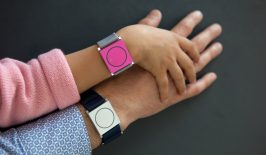For hundreds of millions of sufferers of all types of diabetes, eye disease is one of the most damaging side effects.
All forms of diabetes-related eye disease, mostly related to diabetic retinopathy, a type of creeping blindness, can cause vision loss or blindness. Invasive and painful treatments to reduce long-term damage are regularly utilised, but a new innovation from the California Institute of Technology, proposed by graduate student Colin Cook, may offer a way of reducing damage before treatment is needed.
Cook, together with researchers from the lab of Yu-Chong Tai, Caltech’s Anna L. Rosen Professor of Electrical Engineering and Medical Engineering, has developed a contact lens with glow-in-the-dark properties.
To understand how this helps involves understanding the issue that elevated blood sugar levels over time may cause to the eye. Generally, diabetic retinopathy occurs when the tiny blood vessels in the eye suffer damage. This reduces blood flow to nerve cells in the retina, starving them of oxygen. This can cause them to die. The eye compensates for this by growing new blood vessels to supply oxygen, but they are often poorly developed. These imperfect vessels can bleed clear fluids inside the eye. This causes additional damage, and results in a need for the nerve cells in the outer part of the retina to be removed through laser treatment or injections, which reduces the demand for oxygen, putting a halt on the body’s process of generating new vessels.
Cook and his team looked for other ways to reduce the oxygen demand in a much less invasive way. The glow-in-the-dark contact lenses serve to reduce the metabolic demands on the retina by providing tiny amounts of light. This is done by reducing the activation of the eye’s rod cells, used for night vision, which consume more oxygen in the eye. Providing faint light, generally while the wearer sleeps, reduces oxygen demand and reduces overall damage to the eye.
“Your rod cells, as it turns out, consume about twice as much oxygen in the dark as they do in the light,” Cook said via a Caltech press release. “If we turn metabolism in the retina down, we should be able to prevent some of the damage that occurs.”
Intriguingly, the glow-in-the-dark illumination is provided in the contact lens by micro-sized vials filled with tritium. This is a radioactive isotope of hydrogen that emits electrons, which are converted into light by a phosphorescent coating, providing constant light output – and is reportedly completely safe.
Light therapy for diabetic retinopathy has been attempted before, so the idea itself is not new, but the format is. Previously, lighted sleep masks were offered, but sufferers found it difficult to sleep while ignoring the light shining into their eyes.
The contact lenses have shown a 90 per cent reduction in oxygen demands. Further tests are to be carried out which are expected to reveal some additional prevention of diabetic retinopathy. Following these tests, FDA approval for clinical trials will follow.






